Our second report from the recent Tennessee Valley Interstellar Workshop is the work of Cassidy Cobbs and Michel Lamontagne, with an emphasis on the worldship track. Cassidy has an MS from Vanderbilt, where she studied ecology and evolution. She currently works at Memorial Sloan Kettering Cancer Center, doing traditional and next-generation gene and genome sequencing. Her interest in space travel/engineering was enhanced by attending Advanced Space Academy in Huntsville at age 14. Michel Lamontagne is a French-Canadian mechanical engineer, practicing in the fields of heat transfer and ventilation, with a passion for space. An active member of Icarus Interstellar, he tells me he has “been designing spaceships since he was 12 years old, and waiting for reality to catch up!” Photos throughout are from New York photojournalist Joey O’Loughlin, and are used with permission.
By Cassidy Cobbs and Michel Lamontagne
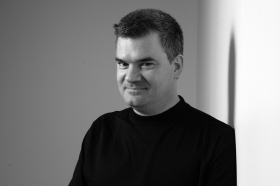
This year’s Tennessee Valley Interstellar Workshop (TVIW-2016) was held in Chattanooga, Tennessee from February 28 to March 2. Attendance was good, reaching the limits determined by the organization committee. Everything seemed to run smoothly, although one can imagine the usual frantic behind the scenes activity required to create that illusion!
Image: Co-author Michel Lamontagne.
The Life Systems Engineering for the Worldship track was very productive, engaging in active work sessions and managing to start interesting lines of inquiry into some the questions of the biological, social, and heat transfer facets of the worldship concept.
In our first working track session, we split into two groups, designated “Biotic” and “Abiotic” to brainstorm on some of the unanswered questions of Worldship theory and design.
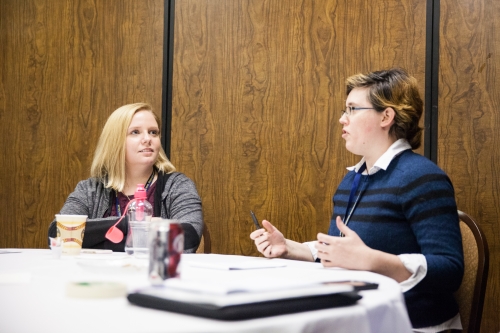
Image: Abigail Sheriff (left), a graduate of the International Space University, and Cassidy Cobbs, co-leader of the Worldship track.
We began populating a whimsical list of included and excluded species, sure to generate heated debate — for example, the entire Australian continent was excluded on account of being too deadly!
We also came up with a number of unexplored questions, including three concerns that we would explore in depth in our Day 2 session: The agricultural framework of a Worldship; how to establish and maintain indefinitely carbon, nitrogen, phosphorus, and oxygen cycling; and how to adapt Earth-normal light, water, and heat cycles to a (much smaller) Worldship.
Cameron Smith (Portland State University) added his ongoing reflections about the human societal aspects of the worldship to the discussions, and provided fascinating parallels with early villages and paleolithic societies, where proto-cities housed small stable communities for periods similar to those expected for a worldship trip.

Image: Biomedical engineer Leigh Boros in the Worldship track. Credit: Joey O’Loughlin.
In our second session, the track split into three groups to look at a few of the questions generated the day before.
Our first group decided to explore some of the changes in heat transfer regimes from living on a sphere with the heat from the outside to living in a cylinder with heat from the inside. We didn’t have the time to work out if we could make it rain in the worldship using only convection cycles, but we agreed that rain would be needed and decided to address the problem in follow-up work sessions on the Internet.
Group two looked at resource cycling, and began to develop the calculations necessary to determine how much of elements such as nitrogen, phosphorus, and oxygen would be needed on board the ship at launch to maintain those natural cycles.
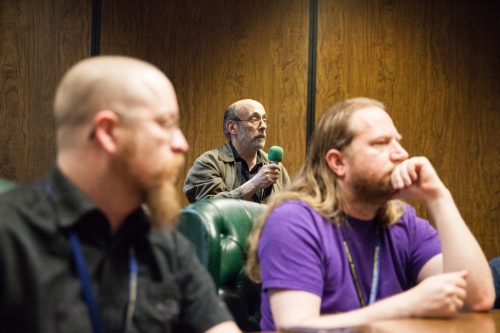
Image: Oz Monroe (left) and Miles Gilster (right), framing Greg Matloff in the background. Credit: Joey O’Loughlin.
The final group explored a potential framework for agri- and aquaculture, creating a list of diverse livestock and crops that would fulfill the nutritional and cultural needs of the humans on board. They also began to think about issues of crop rotation, soil health, and water requirements and to calculate what percentage of land would need to be allocated to agriculture.
The Worldship track was proud to host a new generation of designers, with Hannah Sparkes (age 15) and Ashleigh Hughes (age 17) joining with researchers Anton Smirnov (28) and Andrew Kirkpatrick (26) to ensure that analysis of interstellar worldship engineering has a future.
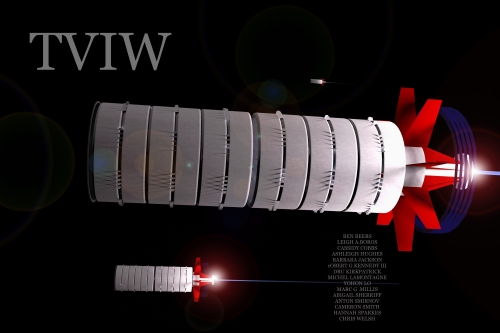
Image: A poster for the worldship track, as prepared by Michel Lamontagne.
For the plenary events, the subjects covered in the papers and talks ranged widely, as usual for TVIW, from starwisps to space wars. Philip Lubin (UC-Santa Barbara) invited the crowd to do the math for his incarnation of the laser-powered sail, one that recently garnered a lot of media attention with a ’30 minutes to Mars’ thought experiment, although the Mars journey is actually only one element of what Lubin sees as a complete Roadmap to the Stars.
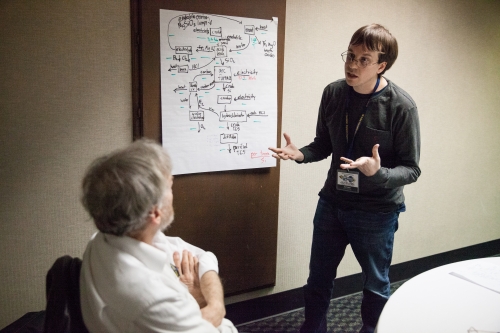
Image: A scene from the Space Mining track. Edwin Etheridge (left) discusses specifics with Matt Ernst. Credit: Joey O’Loughlin.
The Moon vs asteroid mining debate politely raged on, with proponents on both sides and an entire track devoted to exploring detailed mineral processing methods. Melting Lunar basalts to create large caverns for rotating habitats, both in system and at interstellar destinations, was also the subject of an interesting talk by Ken Roy. Meanwhile, the sheer immensity of asteroid resources was highlighted by John Lewis in his keynote address.
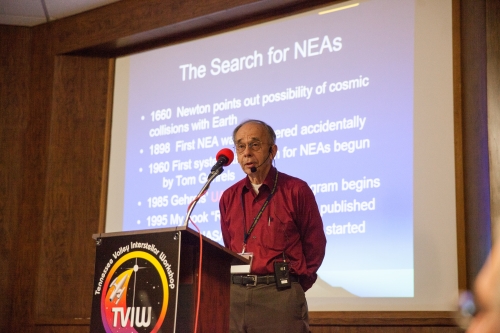
Image: Keynote speaker John S. Lewis (author of Mining the Sky). Credit: Joey O’Loughlin.
Jim Benford proposed beam leakage from propulsion systems as a new SETI venue, inspired in part by the KIC 8462852 light anomalies uncovered in the Kepler planet finder data.
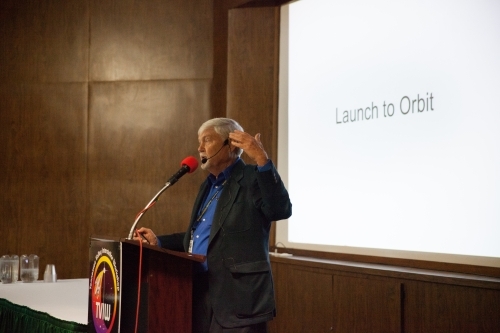
Image: Jim Benford discussing beamed propulsion issues in a SETI context. Credit: Joey O’Loughlin.
Al Jackson revisited and augmented his seminal Interstellar Laser Powered Interstellar Ramjet design, applying graphene to increase performance and setting the ultimate physical limits of the technology. Creating antimatter from space vacuum fluctuations using high energy lasers, as a part of an advanced antimatter drive, while respecting classical conservation of energy, was the subject of the exotic physics talk by Gerald Cleaver.
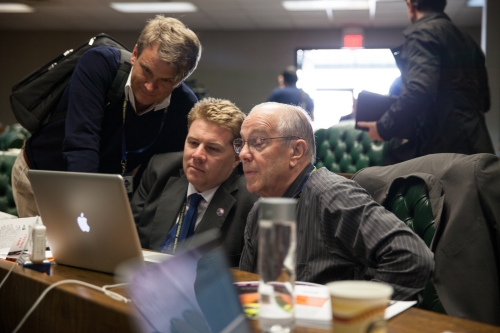
Image: Stefan Zeidler (left), newest member of the board of the Initiative for Interstellar Studies, with i4IS founder Kelvin Long and Bill Cress. Credit: Joey O’Loughlin.



Producing rain in a rotating worldship by a natural process might indeed be hard. I seem to remember reading that raindrops nucleate or condense on dust particles and I’m sure getting condensation might require too much of an atmospheric temperature drop to be practical. Plus, the almost zero gravity near the axis of a worldship cylinder suggests that to get the rain started you might have to shove the condensing water vapor on its way! So how about a high-tech sprinkler system using very pure water and long-lasting pipes that won’t have to be backwashed except every few decades? Perhaps most of the water for crops landscaping might be provide by irrigation anyway, but rain would probably freshen up the air and would help the worldship more resemble a real planet.
Once water is evaporated there would be very few minerals to be deposited in the nozzles and pipes. Water jets or cold air jets may be the way to go, perhaps by freezer condensers cooling the moisture ladened air a?lowing the condensing of the water droplets. I would think a combination of axial irrigation and ground irrigation will be optimum.
Trees and crops are very effective humidifiers. About 30-50% of rainwater is absorbed by trees and crops and re evaporated. So that creates a problem with sprinklers as the air will become extremely humid and uncomfortable in the ship if we do not constantly remove humidity. In other words, the humidity added to the air must be removed constantly, or else it will reach saturation at ambiant temperature and then remove itself through condensation in very uncomfortable conditions. So we are exploring cold traps and condensers, as well as looking at ways of rapidly cooling the atmosphere, as on Earth. But since in a cylinder we have ‘ground’ in every direction, there is nowhere towards which we can radiate away the heat! An interesting design problem.
Sprinklers are very efficient, using about one thousands of the energy required for evaporation to bring water up to the roof. Unfortunately, Earth life evolved on a huge messy planet with lots of light, so we need a large ship with lots of light!
What advances came out of these talks? Was there any new knowledge gained that wasn’t known before? For example, what have we learned about asteroidal or lunar regolith processing that we didn’t know a year ago? Same with enclosed, ecological life support systems. Any solid new ideas, or is this mostly rehashing old ideas and knowledge? Of the ideas raised, what is being done to test their validity behind paper studies?
There is much we do not know about asteroidal and to a lesser extent luna regolith because we just don’t have enough of the material to test thoughly. These regoliths may need some processing first like an acid or alkaline bath, and I would think some rounding of the sharp edges by mechanical tumbling would be needed.
I hope to work with Michael Turner in his Persephone project for some orbital exovivaria built from cubesats as an extension of the Worldship track. So the heat transfer might come in useful some day.
The fusion work at Huntsville (not covered above) is bending metal and piling up capacitors for some real z-pinch fusion experiments.
The electric sail is still a paper ship, but it is an interesting technology for exploration.
Proton beam reduction is also an interesting concept for mineral processing, for which a working space station and a larger scale space program might allow tests to be done.
Very few billion dollars were in evidence though ;-)
The outreach and educational aspects of the conference worked. That’s a tangible result as well.
In the previous 2014 Workshop, three of the four working tracks ended up generating new knowledge in the field. The “A-for Astro” track led to Jim Beall’s wonderful science-fact story, “Our Worldship Broke!” published online by Baen. The “B-for-Bio” track collaborated with ISU, coming up with a novel configuration published by JBIS. The “C-for-Commo” track came up with a new insight into SETI, also published by JBIS. Unbeknownst to them, their conclusion was replicated at a SETI conference taking place at the time across the country. After some lessons learned, the “D-for-Design” track was successfully rebooted by I4IS at BIS HQ late last year. The tracks also proved that diverse people could productively collaborate before, during, and after the Workshop, provided there’s good facilitation/moderation, clear leadership, and rigorous standards, and make meaningful contributions to the field.
The working tracks at TVIW-2016 continued to refine this approach. Perhaps the fastest result came from the SSP track: a presentation of the track’s results at the “D3” (Diplomacy ,Defense and Development) conference in DC *that very night* (March 1-2) by my co-leader LTC Pete Garretson from Air University garnered 4 of the top 7 awards. See: http://www.state.gov/r/pa/prs/ps/2016/03/253805.htm. Speaker’s Homo Stellaris is expected to lead to a bound anthology. The subject of chemical engineering in microgravity/vacuum/temp.extremes is so new, it doesn’t have its own short name yet. Perhaps of greater eventual importance, we brought a couple new generations (Millennials and even younger than that!) into the work, as Michel Lamontagne so ably illustrated above, and Joey O’Loughlin documented with photos. Toni Weisskopf said, “We have to change the narrative” (i.e., that science and exploration is good). Without new blood, especially from new demographics and polities, that change would not happen, and new ideas would not be born. Quite a few of them are makers&hackers, so they won’t stop at just paper. So, TVIW helped there.
I’m proud of what we did.
+1
Successful space explorers know they can’t go anywhere unless someone first frames the journey in the public mind. (Literally, even: http://www.jpl.nasa.gov/visions-of-the-future/ )
These explorers build on inspiration, long before they can build on the tarmac.
If we want to stop them going ..ape.. on each other we have to give them space and plenty of it for a start.
Instead of many million dollar Biosphere projects I think someone should launch a hobby group building glovebox setups to experiment with closed systems. It would be a step up from the last serious researcher I knew of who used test tubes as closed systems.
A nuclear sub offers some ideas, they can remain submerged for years if needed but if that happened the crew could get cabin fever. I have always thought if you have enough energy you can attain at least 99% of what you want to do.
Are you thinking of an expanded version of closed Terrariums?
Not sure if it is true but this one has apparently been going for over 50 years, last watered in 1972.
http://www.dailymail.co.uk/sciencetech/article-2267504/The-sealed-bottle-garden-thriving-40-years-fresh-air-water.html
Yes Rafik , very similar. The test tubes I mentioned had tiny shrimp rather than just bacteria, but they too were allowed to be self governing, in some cases unsuccessfully.
I was thinking of actual glove boxes so that more active experiments could be done. Growing trays tended, some type of small fauna taken care of etc. With glove access you could make, cover and uncover compost piles, process plant material for food etc.
A little more complex would be ports where you could hook up appropriate mechanicals such as dehumidifiers etc.
I think that some of the problems pointed out in these closed systems could be worked out, sometimes with simple procedures.
One thing is for sure, it would open things up to a lot more people than mega projects ever will.
I’m amazed that that sealed bottle garden has managed to keep going that long while being completely sealed. It seems that simple ecosystems are far more stable and robust that you might think.
I wonder if a version of this system could be used for a form of early stage terraforming. Have robots build thick, well insulated versions of these bottles out of local resources. Seed the initial bottles with seeds and compost from Earth. Later bottles containing just regolith & water processed into a soil analog would be connected to the seeded bottles to allow the plants and microbes to colonize the new empty bottles. Volia! self expanding network of self contained green houses. Stand back for a couple of centuries and Mars might have a greenish tinge to it. :-)
This is great. Inspired by my houseplants and aquarium, I have long believed that a closed ecosystem is not nearly as difficult to achieve as it is often presumed around here. Plants are autotrophs, after all: All they need to live is light. Everything else is conserved and recycled in a hermetically sealed environment. The only consumable is light, the only waste is heat.
@Eniac
Not entirely true. Not everything is perfectly recyclable. On Earth it requires some geologic processes to fully recycle some elements, and we know that volcanic dust is needed as a source of trace elements.
Even with a closed ecosystem, the number of organisms is much larger than is visible. Do we just truck shiploads of soil to the destination to ensure that we have a complete ecosystem? We also know that some ecosystems require large animals to maintain them, and this requires a minimum size of an ecosystem , certainly something larger than a farm sized enclosure.
When creating systems to sustain humans, there is no model that we know of yet that will work reliably, especially over the long term.
My guess is that we will have to use artificial methods to maintain such systems, and that the recycling efficiency may be the limiting factor.
Sure, Alex, some ecosystems may require large spaces and diverse organisms, but others don’t, like the bottled plant we were talking about. When we build our ship, we use one that is simple and compact, more like the bottled plant than a rainforest. Provided the story about the plant is true, the proof of concept already exists.
Simple, impoverished ecosystems can be built – you may have bought those saltwater shrimp and alga in a sealed glass globe that last quite a while. The problem is that we cannot exist in such simple environments. They have to be much more complex to support humans (mammals). Biosphere II was a [failed] attempt to do so, and highlights the problems – for example ants overran everything.
You also need to understand that ecosystems are dynamic, not static. Humans manage ecosystems to prevent that change, but that also requires external ecosystem services.
Think small islands as open world ships. They could not maintain themselves without external help. It is romantic thinking to assume that recycling is perfect in nature. It is very efficient, but it isn’t perfect. A worldship on a millennium long journey will have problems with recycling unless we can find a way to do it with 100% efficiency.
Who says we cannot exist in simple environments?
When it comes to basic needs, humans and saltwater shrimp are not so different. We all need food with essential nutrients that plants can largely provide, and we all need oxygen and excrete CO2, water, and various waste chemicals that make great plant food. What works for saltwater shrimp (or fish, for that matter) should work for humans, too. On a much larger scale, with some adjustments (tastier plants, etc) and vitamin pills, but without drastically higher complexity.
The ants that overran Biosphere II probably should not have been there in the first place.
Let’s take a simple case. Phosphorus. The world ship ecosystem will need to produce food for consumption. The crew eat the food and the stools and urine will contain some of the phosphorus. If the wastes are recycled, that cannot be 100% efficient so the phosphorus is lost. If the wastes are simply dumped back into the ecosystem that must be done so that the phosphorus is distributed sufficiently to prevent local shortages. Excess phosphorus cannot be used to fertilize crops as it would have to be removed from the wider ecosystem. The ecosystem could not allow phosphorus sinks like bird or bat guano to occur as this would remove phosphorus from the ecosytem.
On Earth, phosphorus sources are weathered rocks, and sinks include accumulated dead organisms. The cycle is very slow. On a worldship the sources and sinks have to be removed and the cycle regulated to prevent losses. Phosphorus is often teh limiting nutrient. Dump too much in an aquatic environment and you get an algal bloom which dies and sinks locking up phosphorus in the sediment, or worse, kills much of the higher organisms too. This management may well prove impossible to keep at 100% efficiency. Life doesn’t manage it, and relies on new sources from the huge reserves in the mass of the planet.
And that is just one tiny part of the recycling of nutrients issue. At this point I think we are playing handwavium on the difficulties of maintaining closed systems for a world ship. I think the proposed Mars agriculture project is more achievable as it doesn’t have to be fully enclosed for decades, centuries, even millennia.
I suppose nothing stops us ‘eventually’ building a very large habitat say around Mars and studying the relationships between various components before we set off on one way trip.
Sure. How long must we test it before we make an interstellar flight? 100 years? 1000 years? Good idea to start as soon as possible, starting with Earth bound structures.
You might enjoy the work of Michael Turner with his Persephone project
http://www.projectpersephone.org/drupal/index.php
and
https://www.facebook.com/groups/530398163680862/
on facebook
The Persephone Project looks interesting. However it has some incorrect information. While looking at the exovivaria section (following a thread in the comments) I read a statement that the JAXA “Kibo” module has a centrifuge to simulate 0.1 – 2 g. I’ve been wanting these partial g experiments for a long time. But, in fact this module was not launched and so Kibo cannot do experiments on life under different g.
I am slightly off put about the ship design by Michel, the rotation rings give a much larger oncoming debris intercept area, having them edge on would reduce the intercept area and therefore the mass of shielding required. Unfortunately when I drew the design in mind it looked like a goldfish from the side!
It’s hard to create a sexy design. My own looks rather like a large tin can, and even has about the same proportions ;-) I must say I feel the risk of impact is over rated and is probably not a very important design criteria, particularly for a relatively slow worldship. There is a large plate at the front of the ship, made up of a lot of useful frozen stuff, ready to evaporate on impact.
Daedalus used a 9mm berylium placte for 40 yeat at 14% of the speed of light. As impact energy is linked to the square of the velocity, a ship going at 1% of the speed of light will need 200 times less protection. So literaly a thick coat of paint can do the job for all particulate mater and gases, excluding large dust grains and pebbles which need to be handles with whipple shields or similar evaporative arrangements.
Worldships are slow.
@Michel
Might it be better to have the rotation in the direction of travel, this would give the added advantage of addition impact shielding i.e. an impact will have to go through addition material that is used as part of another function. If we say had the low gravity environment ‘wheel’ in the front the soil would act as a strong impact material absorber. We could also have a second smaller ‘inner’ wheel which rotates faster to act as a wind generator and water irrigator and higher ‘G’ human control centre over looking the food growing area.
I think it would be similar. I don’t think we have enough data to state definitively what would be better. I prefer that in my configuration the impact happens on a static plate, while in the configuration you propose the impact would damage a surface that is under considerable tension due to the induced hoop stress from the centripetal force and the internal pressure.
One of the main dangers from impact is secondary radiation, as the impactor and whatever it hits turns into energetic plasma, and emits some high energy radiation, and some pretty fast debris.
We are planning on using an inner wheel, but only as a static ceiling to save on atmospheric mass. There would be an important sealing problem at the interface of an inner wheel and an outer wheel rotating at different velocities.
If we create temperature differences in the ship habitat, that will automatically generate wind as hot and cold air masses move around.
Most of the worldship will be a ‘park’, we believe. Biological diversity is not very compatible with food production. If you look at Earth, the actual food production areas are not that large. These food areas depend on the stability of a large reservoir of life that is not ‘productive’ in a narrow economical sense, but required.
We are planning on having a water buffer between the outer and an inner hull. A hidden ocean, in a way. But probably no more than 5m thick. That should absorb radiation and provide a nice amont of mass to absorb energy.
It is always nice to see these design come to life, it sort of indicates we are at least getting somewhere.
With the forward rotation design the soil and then air will act as great primary and secondary radiation protection, a back wheel near the engine having a water theme would protect the crew in the middle from neutrons emitted by the engine. The hoop stress in the front and back wheel is less due to the slower rotation needed for the plant and aquatic areas. Perhaps a hybrid design of a front and back facing wheels and the wheels axially in the centre will be better, it is nice have some options. The water jacket is a good idea hopefully it would never freeze or it would be catastrophic.
Don’t forget that the neutrons from the drive have high kinetic energy, and that stopping them will convert the energy into heat. From our calculations, many types of fusion drives will emit too many neutrons for a working ecosystem to absorb all that energy. Deuterium deuterium fusion is about 30% neutrons, deuterium tritium almost 75% neutrons. Deuterium helium three has no neutrons but there are a lot of side reactions that do produce neutrons (in a deuterium helium 3 mix some of the deuterium atoms will fuse together). Careful design might allow most of the neutrons to be absorbed in the fusion exhaust. The problem is that no one really knows how much ‘most’ is.
And neutrons tend to damage materials, a phenomenon called neutron embrittlement. We would want to limit this damage to some easily repairable shield, rather than to the walls of one of our living areas, even if it is only a farm, or a sea.
Fusion drives also produce copious amounts of x-rays. These also produce a lot of heat when they are absorbed. Even the most enthusiastic supporter of aneutronic fusion will admit that the x-rays should produce quite a bit of heating around the drive area. Again, optimists will have the x-rays absorbed by the fusion drive reaction products themselves.
The water jacket freezing should not be so bad if the interior surface is flexible enough to move under the expansion of the ice. But it is indeed a risk. In deep space, almost any liquid will freeze. Eventually, even the nitrogen and oxygen in the atmosphere will freeze out.
We expect a ship will not be able to last without constant monitoring, maintenance and repair. So goodbye to all the stories of lost worldships with crews that don’t know that they are in space. Worldships are probably not stable self damping structures in the first place, so they will require constant intervention to prevent amplification of unwanted vibrations, and eventually deadly wobbles. So keeping water from freezing should be a piece of cake.
We hope ;-)
Yes neutron embrittlement is an issue, re-annealing could cure most of it with added vapour dispositions/annealing to coat thinning regions. An engine shut down every now and then will be needed as part of the ships engine maintenance I suspect, give the crew something to do.
Water is a great neutron absorber/moderator which we would need on a trip anyway so sticking it at the back close to the engine makes sense. Placing the source of the explosion as far out as possible and inclining materials for shallow angle neutron reflections would help as well. Its a pity we could not generate Xe135 insitu ‘efficiently’ as it has a phenomenal neutron absorption area of hundreds of thousand to millions of times that of water! There is the possibility of magnetic fields deflecting neutrons as well but they would have to be very, very strong to achieve a great effect.
I think you may be underestimating the power required for the drive of a large Worldship, and what might be the neutron radiation level. As originally defined by Bond and Martin, a worldship is a vessel designed for 100 000 people, about 10 km in diameter and about 100 km long. The one we are working on is slightly smaller, with 40 000 people, at 10 km by 30 km with a low population density, or 5 km x 15 km with a higher population density. The drive power for the smaller ship, with a continuously firing drive over a ‘short’ 500 year trip to Alpha Centauri is 6 million Gigawatts. Even only 1% of that is 60 000 GW, for a 99% efficient drive. But the entire heating load required for the habitat is only 57 GW. So heating the habitat and providing all the power possibly required by the crew is a minor portion of a very optimistically low thermal load from the drive. Almost incidental. But still equivalent to 57 nuclear power plants.
A Worldship is truly a world. Not just a big spaceship. It only makes sense if a complete ecology turns out to be required for long term flight and colonisation. Most likely, it doesn’t really need to colonize planets, just have access to ressources. Otherwise, much smaller ships can do the job, using high efficiency farms and much smaller living areas and much more intense technology. A reduction of one or two orders of magnitude is then possible. The term ‘Colony ship’ has been proposed for these smaller ships. Much smaller ships are also possible from ‘zygote’ ships and to ‘information’ microships.
That is a serous amount of energy dissipation, the drive will need to steer away form neutrons as far as possible, even other ships nearby would be affected. With that amount of power dissipation perhaps a very thin thermal reflector could be used to redirect the thermal energy backwards as added thrust or use the radiator fins at an angle to keep the torus’s rotating without out the need for powerful engines.
Just thinking about the front shield if metals are used, if it is very thin and parabolic in construction it could double up as a very large front facing telescope mirror, impacts will go straight through and will have minimal effects on the quality of the images.
Thinking about the neutron issue, there may be a simple solution by the use of nanotubes. Nanotubes have the neat ability of internally deflecting neutrons, if we covered all of the engine intercept area with these tubes we could deflect a lot of them either to the side or even 180 degrees to act as added thrust.
It’s good to see some movement away from rocket launches, but I still see no wholesale embrace of StarTram for cargo and Skylon for cargo and people as the key moves necessary to open up space activities by radically lowering bucks per launch payload kilogram. We could be planning StarTrams right now.
It’s hard to create a sexy design. My own looks rather like a large tin can, and even has about the same proportions ;-) I must say I feel the risk of impact is over rated and is probably not a very important design criteria, particularly for a relatively slow worldship. There is a large plate at the front of the ship, made up of a lot of useful frozen stuff, ready to evaporate on impact.
Daedalus used a 9mm beryllium plate for 40 years at 14% of the speed of light. As impact energy is linked to the square of the velocity, a ship going at 1% of the speed of light will need 200 times less protection. So literaly a thick coat of paint can do the job for all particulate mater and gases, excluding large dust grains and pebbles which need to be handles with whipple shields or similar evaporative arrangements.
Worldships are slow.
No market, no competition= no launching system.
StarTram and Skylon are only efficient for large volumes. A single Skylon, or even just half a dozen, are not economical since they cannot recoup their development costs, compared to legacy chemical rockets.
Star Tram would not be effective launching 12 satellites per year. And as far as energy from space, it is much less risky to build a natural gas plant and burn what comes out of holes in the ground.
Regarding a lack of “wholesale embrace” of any of the ideas for cheaper access to space (e.g. Space X, ULA, Skylon, etc.), that is a societal phenomenon. It is so ‘normal’ for us to have our pet favorites and then want all the rest to follow along. But, what can we do at the individual level? Option A: Devote one’s energies to advocating our pet ideas, hoping someday we’ll get support. Options B: Devote one’s energies to actually working on one’s pet idea, improving it to whatever degree you can – and show that you have what it takes to make progress.
On a related note, there is a common misconception that we should wait until the nearer term problems have been solved before investigating what might come later. When you look at historically significant advances (e.g. Steamships over sail, Transistors over vacuum tubes, rockets over aircraft, etc), none of those were started ‘after’ their predecessor were done. It makes sense to have a blend of activity on both the foreseeable and embarking into the unknown. Here, with the topic being interstellar flight, we provide the venue to consider what the near-term space programs cannot. Instead of down-selecting from a menu of what we already understand, here we are planting the seeds for the grander achievements that will follow.
Andrews, Skylon played a big role in the space solar power workshop. One of the motivations for space solar power was that it would provide a business impetus for cheap reusable launch capacity. Skylon seems like the best candidate, StarTram was not discussed, as far as I recall.
@Michel
Just thinking, what did you have in mind to illuminate the rotating rings?
We need to supply on average about 250 W/m2, with peaks up to 1200 W/m2. As we have decided to use a series of torus as our basic ship structure we can have a ceiling on which to install lights. It would be best to simulate sunlight as closely as possible.
I think some kind of LED would probably do the trick, and if we can design them to last at least a few decades, robotic replacement systems could keep them going and recycle them to build new ones.
Combining them with a scattering screen such as described here might be the ultimate package.
http://www.zmescience.com/science/physics/artificial-light-like-natural-light-0654654/
I expect that at a few hundred meters high the human eye doesn’t have the resolution to distinguish the fact that they would not be perfectly continuous.
They would just be switched on for the day and turned off at night.
It seems simpler than the hot fusion line which is often proposed, the ‘long sun’, since fusion actually puts out a lot of x-rays and high energy photons, that would need to be converted into more usable wavelengths by using plasmas, gases and such.
Yes the long sun is more problematic and LED more promising, LED’s also have the ability to be ‘tuned’ to a set of frequencies, aquatic organisms, humans and plants don’t have the same frequency needs so they can be tailored to suit certain areas.
Perhaps a conduit direct from the engine chamber will allow some of the radiation and particles to excite crystals lining the conduit to glow as a back up. Perhaps they will also be allowed to flow out the front to act as an interstellar gas and dust remover as well.
Worldships are probably going to be build quite some time after orbital colonies, since their mass, energy and ecological stability requirements are much higher. So there should be quite a lot of experience available by then. We should also expect the construction of a worldship to take a fair amount of time, just because of the large masses involved. Finally, as natural world experiments such as the reforestation near Mt St Helens and the new Island of Surtsey in Iceland show, it takes time to install an ecology, but not millennia. https://en.wikipedia.org/wiki/Surtsey
Constructing the huge ships may take as long as the journey!
I suppose we could build the rotational bits for habitation and then much later add the engines, the habitats can be occupied for hundreds for years before a decision is made to build the engines and move the ships outwards. With any luck the engines are a lot cleaner burning and more efficient in the future but in the meantime we have spaces to live in.